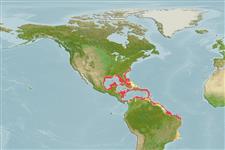Environment: milieu / climate zone / depth range / distribution range
Ecologia
marinhas demersal; intervalo de profundidade 35 - 365 m (Ref. 5222), usually 35 - ? m (Ref. 40849). Subtropical; 35°N - 22°S, 98°W - 35°W (Ref. 5222)
Western Atlantic: off North Carolina (pelagic post-larva, possibly drifted north from Florida or the Bahamas) to the Gulf of Mexico, Caribbean, and south to Vitoria, Brazil.
Tamanho / Peso / Idade
Maturity: Lm ? range ? - ? cm
Max length : 30.0 cm TL macho/indeterminado; (Ref. 7251)
Espinhos dorsais (total) : 8; Raios dorsais moles (total) : 13; Espinhos anais: 3; Raios anais moles: 7. Distinguished by the following characteristics: head, body, dorsal and caudal fins yellow; 6-7 salmon-colored stripes from the head to the soft dorsal and caudal fins; blood-red blotch on the front half of anal fin; white blotch on the side of belly; pinkish purple pelvic fins; depth of body subequal to head length, depth contained 2.3-2.5 times in SL; width of body 2.3-2.4 times in body depth; head length 2.2-2.3 times in SL; convex interorbital area, convex dorsal head profile; rounded preopercle, with large, curved spine at angle, lower edge fleshy; very large middle opercle spine, extending to or beyond rear edge of opercular membrane; small posterior and anterior nostrils, subequal; well-developed supramaxilla and prominent bony knob (hidden by upper lip) on lower rear corner; short, curved, fixed canine tooth on each side of symphysis of both jaws and midside of lower jaw with 1-3 similar fixed canines (Ref. 89707).
A solitary species (Ref. 26340) inhabiting sandy bottoms and reefs (Ref. 89707). A beautiful and hardy species in the aquarium, prefers cooler waters and not good community dwellers for they are active piscivores (FB user, 27/04/12 ).
Life cycle and mating behavior
Maturidade | Reprodução | Desova | Ovos | Fecundidade | Larvas
Heemstra, P.C. and J.E. Randall, 1993. FAO Species Catalogue. Vol. 16. Groupers of the world (family Serranidae, subfamily Epinephelinae). An annotated and illustrated catalogue of the grouper, rockcod, hind, coral grouper and lyretail species known to date. Rome: FAO. FAO Fish. Synop. 125(16):382 p. (Ref. 5222)
Categoria na Lista Vermelha da IUCN (Ref. 130435: Version 2024-1)
Ameaça para o homem
Harmless
Utilização humana
Pescarias: pouco comercial; Aquário: Potencial
Ferramentas
Relatórios especiais
Descarregue XML
Fontes da internet
Estimates based on models
Preferred temperature (Ref.
123201): 17.7 - 27.2, mean 23.9 °C (based on 222 cells).
Phylogenetic diversity index (Ref.
82804): PD
50 = 1.0000 [Uniqueness, from 0.5 = low to 2.0 = high].
Bayesian length-weight: a=0.01148 (0.00553 - 0.02385), b=3.04 (2.88 - 3.20), in cm total length, based on LWR estimates for this (Sub)family-body shape (Ref.
93245).
Nível Trófico (Ref.
69278): 3.8 ±0.6 se; based on size and trophs of closest relatives
Resiliência (Ref.
120179): Médio, tempo mínimo de duplicação da população 1,4 - 4,4 anos (Preliminary K or Fecundity.).
Fishing Vulnerability (Ref.
59153): Low vulnerability (20 of 100).
